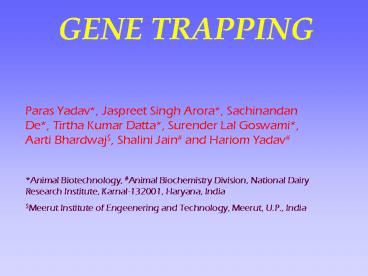GENE TRAPPING PowerPoint PPT Presentation
Title: GENE TRAPPING
1
GENE TRAPPING
Paras Yadav, Jaspreet Singh Arora, Sachinandan
De, Tirtha Kumar Datta, Surender Lal Goswami,
Aarti Bhardwaj, Shalini Jain and Hariom
Yadav Animal Biotechnology, Animal
Biochemistry Division, National Dairy Research
Institute, Karnal-132001, Haryana, India Meerut
Institute of Engeenering and Technology, Meerut,
U.P., India
2
What is gene trapping ?
Gene trapping is a form of insertional
mutagenesis specifically designed to disrupt
gene function by producing intragenic
integration events.
Evans, M.J. (1998) Dev. Dyn., 212, 167-169
3
A random integration of a reporter gene
construct, called entrapment vector into
genome.
- Productive integration events bring the reporter
gene under the transcriptional regulation of an
endogenous gene.
4
Regulatory Components of a Gene important for
its expression
Enhancer a set of short sequence elements which
stimulate transcription of a gene.
Promoter a combination of short sequence elements
to which RNA polymerase binds in order to
initiate transcription of a gene.
Polyadenylation addition of typically 200 A
residues to the 3' end of a mRNA. The poly(A)
tail is important for stabilizing mRNA.
5
Basic Strategy in Gene Trap
6
Gene trap Strategy
Choosing proper vector and delivery system
Selecting the clones with markers
Identification of location of the insert in the
clone
Studying biological questions Production of
chimeras
7
Components of gene trap
- Mouse or human embryonic stem cell (for mammalian
model) - Entrapment vector construct having the reporter
gene and selectable marker.
8
Reporter genes
- The E.coli lacZ gene
- The E.coli. Chloramphenicol acetyltransferase
(CAT) gene - The firefly luciferase gene
- The jelly fish green flourecence protein (GFP)
gene
9
Selectable Markers
- Positive selection
- Neomycin phosphotransferase gene (neoR)
- Puromycin selection (Puro)
- Negative selection
- Herpes Simplex Thymidine kinase gene (hsv-tk)
- Diphtheria toxin gene
10
Types of vectors
- Enhancer trap vector
- Promoter trap vector
- Gene trap
- poly A trap
11
Enhancer Trap
Endogenous gene X
Vector
P'
promoter
neo
lac Z
pA
pA
Exon 1
Exon 2
Exon 3
Enhancer
Vector Integration
DNA
neo
promoter
lac Z
lac Z
neo
RNA
proteinX
ß-gal
NeoR
protein
12
Promoter Trap
- Endogenous gene X
P'
lac Z
neo
pA
pA
Vector Integration
DNA
lac Z
neo
RNA
neo
lac Z
proteinX
protein
ß-gal
NeoR
13
Gene Trap
- Endogenous gene X
P'
lac Z
neo
SA
pA
pA
Vector Integration
lac Z
SA
neo
DNA
Spliced transcript
neo
RNA
lac Z
SA
proteinX
protein
NeoR
ß-gal
14
Poly A Trap
- Endogenous gene X
P'
neo
lac Z
SA
SD
pA
Vector Integration
neo
lac Z
SA
DNA
pA
SA
lac Z
neo
RNA
pA
proteinX
protein
NeoR
ß-gal
Nature Reviews Genet 2756 (2001)
15
Special types of Trapping
(keeping functional objectives in view)
1. Secretory trap
2. Cre-loxP system
3.Chromosomal deletion using Negative selection
4. Protein trap
16
1. Secretory Trap Basic strategy
17
Secretory Trap Improved strategy
Protein
18
Identification of role of specific gene during
development
Trapped Gene name
Coronal sections of forebrains showing PLAP
expression in Secretory trap in mouse at birth
Area of brain
Nature 410174 (2001)
19
2. cre-loxP mediated excision
20
(No Transcript)
21
3. Protein Trap
Introns
Brief Funct Genomic Proteomic. 2137 (2003)
22
Expression of trapped genes (GFP) in different
developmental stages
FEBS Letters 48063 (2000)
23
Vector Delivery
1. Chemical method using reagents to package
vector DNA
2. Electroporation Applying electrical forces to
enhance cell membrane pores
3. Biological system Viral infection with
adeno, lenti or retroviral vectors
24
Identification of insert location
1.Using a Rescue Vector strategy
2.Using a Expression of the reporter/marker
gene- RACE
25
Applications of gene trap
26
Labeling Cell Lineages
Effect of mutagenesis
Gene Trap
Chromosome Trap
Identifying New Genes
Induced Deletions
27
Gene trap helps in annotation of genome and
identifying new genes with unknown function
Nucleic Acids Research 32 3995 (2004)
28
Studying X- chromosome Inactivation in Human
Alleles
Gel
Nucleic Acids Research (2004)
29
Using gene trap method this study concluded that
In human extra-embryonic tissue (placenta), X
inactivation is of non- random type.
One can learn more about epigenetics using
trapped clones and identify imprinted genes
(those are expressed from one chromosome only) .
Nat Genet. 28310 (2001).
30
Should not be confused with gene targeting
31
Integration of genomic DNA into
mammalian cell genome by homologous
sequence recombination.
What is gene targeting?
- It is usually used to create direct mutagenesis
in mammalian cell particularly in mouse embryonic
stem cell. - Phenotypic consequence of specific genetic
modification can be assessed in the organism
(e.g. loss of function ).
32
Gene Targeting
Negative selection
Positive selection
Vector
neo
TK
x
x
Chromosome
gene
Homologous recombination
Targeted locus
neo
33
Limitations of gene trap
1. Lack of effective prescreening of trapped
genes. 2. Integration of multiple copies of the
trap vector etc. 3. Biasness of the trapping
vectors. 4. Cannot be used for genes which are
permanently switched off. 5. Particular
gene of interest may not be mutated. 6. Effect of
Differential and Alternative Splicing.
34
Thanks

